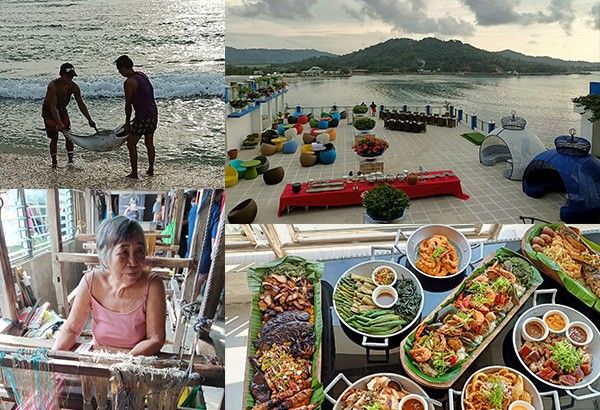Discover Santiago, Ilocos Sur's hidden gem

ILOCOS SUR, Philippines — Santiago, one of Ilocos Sur's 32 municipalities, is a hideaway waiting to be rediscovered; time and again.
This quaint locale, south of Vigan, boasts of a picturesque cove, thriving cottage industries, as well as gustatory indulgences concocted from fresh catch and farm produce.
Santiago Cove, a kilometer stretch of pristine coastline, bodes a rosy future for Ilocos Sur's ecotourism initiatives. "We are ecstatic that we're making an impact through the hotel's crusades to inspire the community, through our CSR (corporate social responsibility) efforts. And we always remind our team to carry the warmth of 'pagmamalasakit' or concern to all the guests and visitors, as well as the company as this helps us stand out," intoned general manager Chester Delos Reyes Velas.
A boutique hotel with spacious accommodations, Santiago Cove Hotel is a must-visit destination in the coastal side of Ilocos Sur. The deluxe rooms are amply-sized at 25 sq. m., the premium deluxe at 28 sq. m., while the junior suites are 30-square-meter "corner delights." On the other hand, the family suites come with a spacious 36 square-meter floor area. All the air-conditioned room options, sprawled in three floors, come with a flat-screen TV, a dresser-cum-worktable, and Wi-Fi connection that allows guests to stay in touch with the rest of the world, while enjoying their vacation.
Painted in the Hellenic colors of blue and white, the hotel, as the local government wants, sets an impression that guests are somewhere in Santorini, and not just up north. "The color white speaks of the purity of Santiago residents, while blue mirrors the clear waters of the cove. It was a risk that we were willing to take even from the start. And looking at it now, we're confident that it turned out well," shared sales and marketing director Diane Tongol-Miranda.
Anticipating a boom in its guest attendance, the hotel, located in the town's Sabangan Beach area, launched its four-storey annex that will house a 300-seater ballroom, a coffee shop, roof deck bar, and premier suites overlooking the expansive cove. If the last phase of the decorative work goes according to schedule, the annex will be fully operational by mid-December, or earlier.
Epicurean delights
Tiny Wave, the hotel's poolside bar, proffers Asian fare, including Korean and Japanese unlimited grilling of fresh seafood like tuna, dorado, clams, mussels, shrimps, and the like.
Rodrigo's Roast + Resto-Bar, an all-dining restaurant, specializes in authentic Ilocano and Pinoy dishes with a modern flair. Their Merienda Cena spread is a gourmand's dream destination.
"In Ilocos, no Lechon is as flavorful without the Karimbuaya stuffing, an edible cactus variety, that creates a distinct, savory taste and aroma," informed Chef Chester Delos Reyes Velas, the property's food and beverage consultant and general manager, the brains behind all the sumptuous fare in all its food outlets.
And for fans of haute cuisine, its roofdeck outlet Fish serves fresh ideas to most favorite dishes you've sampled before. Revel in their Guinabang River Balingasang dish, a surprising concoction you might mistake as pasta, but is an ingenious melding of julienne strips of bamboo shoots with scallops and bacon!
Thriving SMEs
The 82-year-old Corazon Agosto is the oldest-living loom weaver in Santiago. The cottage industry of loom weaving started as an industry in 1975. But Manang Corazon started weaving in 1961, with the other women in her family at the age of 20. Nikki Coseteng was their first patroness.
Nowadays, at Grade 10 or 11, the younger women in her family were already taught the rigors of the trade every weekend; most especially during the lockdowns. Each loom weaver finishes three yards of woven cloth every two days, for eight hours of work each day. The finished weave sells at P1,500. Itneg designs from Abra gets assimilated into the weaving patterns.
Strangely, while the rest of the world was greatly affected by the pandemic, Santiago weavers got steady patronage during the lockdowns, especially for the beautifully-woven face masks they've made. Today, local government units in Ilocandia have made the Abel Iloko the main textile in their uniforms.
Sixty years into the craft, and several generations of women in Manang Corazon's family, the CCA Ethnic Handloom Weaving, has continuously forged into the 21st century - and way into the future.
Barangay Ambucao also serves as the town's tuna fish docking area. Yellow fins are easily caught some five miles into the open sea. But the bigger species are caught, mostly, from eight to 10 miles out.
The stretch of Caburao, on the main highway, is a blacksmith's haven where one can find blades, samurai, and other razor products of varying sizes on display; proving the art of
"pandayan" is as strong as ever.
Double celebration
The formal launch of the hotel also coincided with the 66th natal anniversary of its owner, incumbent Vice Mayor Josefino "Boy" Miranda. Ilocos Sur Governor Jerry Singson was the toast master of the celebration.
"Local visionaries believe that Santiago is the future of Ilocos Sur. Like my father-in-law's friend Josefino, he has so much belief in beautifying the cove area because he wants this place to be internationally recognized as a tourist destination. We are confident that this place we call home has a lot to show, as we have all sorts of experiences we want our guests to discover and cherish. There's so much that Santiago can offer," enthused Dianne.
---
Editor's note: The tour to Santiago was hosted by Santiago Cove Hotel to promote tourism in the area. At no stage does the host organization have a say on the stories generated from the coverage, interviews conducted, publication date and story treatment. Content is produced solely by Philstar.com following editorial guidelines.



















